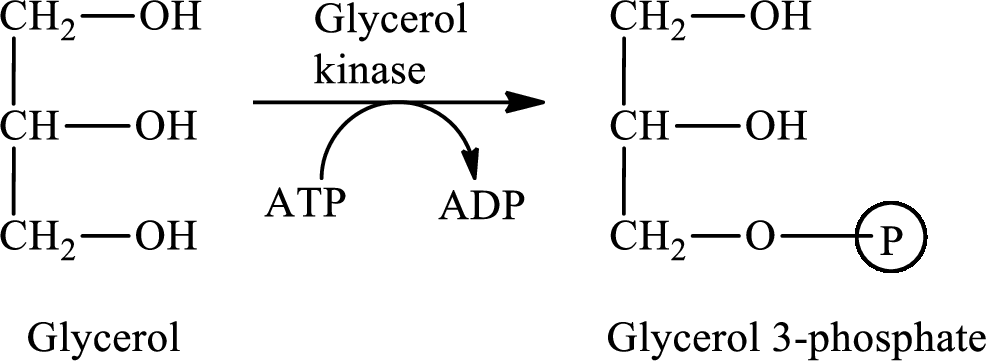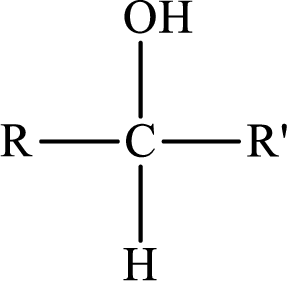
Concept explainers
(a)
Interpretation: To determine the step of glycerol
Concept introduction: Triacylglycerol mobilization is an ongoing process in which triacylglycerols that are stored in the adipose tissue are hydrolyzed. Fatty acids and glycerol are the products of triacylglycerol mobilization. The products are released into the bloodstream.
After entering the bloodstream, the glycerol travels to the kidneys or liver. The first stage of glycerol metabolism occurs in the liver or kidney. The first stage of glycerol metabolism is a two-step process. After the first stage, the remaining stages of glycerol metabolism are the same as glucose pathways. The overall equation for glycerol metabolism is as follows:
Nicotinamide adenine dinucleotide is associated with the
(a)
Answer to Problem 14.20EP
The oxidizing agent
Explanation of Solution
The first stage of glycerol metabolism is a two-step process. In step 1,

Here, represents
represents
In step 2 of glycerol metabolism,
(b)
Interpretation: To determine the step of glycerol metabolism in which ADP is produced.
Concept introduction: Triacylglycerol mobilization is an ongoing process in which triacylglycerols that are stored in the adipose tissue are hydrolyzed. Fatty acids and glycerol are the products of triacylglycerol mobilization. The products are released into the bloodstream.
After entering the bloodstream, the glycerol travels to the kidneys or liver. The first stage of glycerol metabolism occurs in the liver or kidney. The first stage of glycerol metabolism is a two-step process. After the first stage, the remaining stages of glycerol metabolism are the same as glucose pathways. The overall equation for glycerol metabolism is as follows:
Adenosine triphosphate (ATP) is a triphosphate
(b)
Answer to Problem 14.20EP
ADP is produced in step 1 of glycerol metabolism.
Explanation of Solution
The first stage of glycerol metabolism is a two-step process. The first step of glycerol metabolism requires energy that is provided by ATP. In this step, glycerol is converted to
The

Here, represents
represents
Therefore, ATP is consumed in step 1 which is further converted to ADP in glycerol metabolism
(c)
Interpretation: To determine the step of glycerol metabolism in which
Concept introduction: Triacylglycerol mobilization is an ongoing process in which triacylglycerols that are stored in the adipose tissue are hydrolyzed. Fatty acids and glycerol are the products of triacylglycerol mobilization. The products are released into the bloodstream.
After entering the bloodstream, the glycerol travels to the kidneys or liver. The first stage of glycerol metabolism occurs in the liver or kidney. The first stage of glycerol metabolism is a two-step process. After the first stage, the remaining stages of glycerol metabolism are the same as glucose pathways. The overall equation for glycerol metabolism is as follows:
A reactant is defined as the substance that is initially present in the chemical reaction and gets consumed to form a new substance.
(c)
Answer to Problem 14.20EP
Explanation of Solution
The first stage of glycerol metabolism is a two-step process. In step 1,

Here, represents
represents
Therefore,
(d)
Interpretation: To determine the step of glycerol metabolism in which secondary alcohol is oxidized.
Concept introduction: Triacylglycerol mobilization is an ongoing process in which triacylglycerols that are stored in the adipose tissue are hydrolyzed. Fatty acids and glycerol are the products of triacylglycerol mobilization. The products are released into the bloodstream.
After entering the bloodstream, the glycerol travels to the kidneys or liver. The first stage of glycerol metabolism occurs in the liver or kidney. The first stage of glycerol metabolism is a two-step process. After the first stage, the remaining stages of glycerol metabolism are the same as glucose pathways. The overall equation for glycerol metabolism is as follows:
In the secondary alcohol, the carbon atom of the hydroxyl group

Here, R and
(d)
Answer to Problem 14.20EP
Secondary alcohol is oxidized in step 2 of glycerol metabolism.
Explanation of Solution
The first stage of glycerol metabolism is a two-step process. In step 1,

Here, represents
represents
Want to see more full solutions like this?
Chapter 14 Solutions
Organic And Biological Chemistry
- Using the Nernst equation to calculate nonstandard cell voltage Try Again Your answer is wrong. In addition to checking your math, check that you used the right data and DID NOT round any intermediate calculations. A galvanic cell at a temperature of 25.0 °C is powered by the following redox reaction: 2+ 2+ Sn²+ Ba(s) (aq) + Ba (s) Sn (s) + Ba²+ (aq) →>> Suppose the cell is prepared with 6.10 M Sn 2+ 2+ in one half-cell and 6.62 M Ba in the other. Calculate the cell voltage under these conditions. Round your answer to 3 significant digits. 1.71 V ☐ x10 ☑ 5 0/5 ? 00. 18 Ararrow_forwardQuestion: Find both the b (gradient) and a (y-intercept) value from the list of data below: (x1 -x̄) 370.5 (y1 - ȳ) 5.240 (x2 - x̄) 142.5 (y2 - ȳ) 2.004 (x3 - x̄) 28.5 (y3 - ȳ) 0.390 (x4 - x̄) -85.5 (y4 - ȳ) -1.231 (x5 - x̄) -199.5 (y5 - ȳ) -2.829 (x6 - x̄) -256.5 (y6 - ȳ) -3.575arrow_forwardCalculating standard reaction free energy from standard reduction... Using standard reduction potentials from the ALEKS Data tab, calculate the standard reaction free energy AG° for the following redox reaction. Be sure your answer has the correct number of significant digits. 3Cu+ (aq) + Cro²¯ (aq) +4H₂O (1) → 3Cu²+ (aq) +Cr(OH)3 (s)+5OH˜¯ (aq) 0 kJ ☐ x10 00. 18 Ararrow_forward
- Calculating the pH of a weak base titrated with a strong acid An analytical chemist is titrating 241.7 mL of a 0.4900M solution of methylamine (CH3NH2) with a 0.7800M solution of HNO3. The pK of methylamine is 3.36. Calculate the pH of the base solution after the chemist has added 17.7 mL of the HNO3 solution to it. Note for advanced students: you may assume the final volume equals the initial volume of the solution plus the volume of HNO3 solution added. Round your answer to 2 decimal places. pH = ☑ ? 18 Ararrow_forwardThe following is two groups (Regular tomato sauce & Salt Reduced Tomato Sauce) of data recorded by a team analysising salt content in tomato sauce using the MOHR titration method: Regular Tomato Sauce Salt Reduced Tomato Sauce 223.4 148.7 353.7 278.2 334.6 268.7 305.6 234.4 340.0 262.7 304.3 283.2 244.7 143.6 QUESTION: For both groups of data calculate the answers attached in the image.arrow_forwardThe following is a two groups (Regular tomato sauce & Salt Reduced Tomato Sauce) of data recorded by a team analysising salt content in tomato sauce using the MOHR titration method: Regular Tomato Sauce Salt Reduced Tomato Sauce 340.0mmol/L 262.7mmol/L QUESTION: For both groups (Regular & Salt Reduced tomato sauce) of data provide answers to the following calculations below: 1. Standard Deviation (Sx) 2. T Values (t0.05,4) 3. 95% Confidence Interval (mmol/L) 4. [Na+] (mg/100 mL) 5. 95% Confidence Interval (mg/100 mL)arrow_forward
- If we have leucine (2-amino-4-methylpentanoic acid), alanine (2-aminopropanoic acid) and phenylalanine (2-amino-3-phenylpropanoic acid), indicate the tripeptides that can be formed (use the abbreviated symbols Leu., Ala and Phe).arrow_forwardBriefly state why trifluoroacetic acid is more acidic than acetic acid.arrow_forwardExplain why acid chlorides are more reactive than amides in reactions with nucleophiles.arrow_forward
- Calculating the pH of a weak base titrated with a strong acid An analytical chemist is titrating 101.7 mL of a 0.3500M solution of piperidine (C5H10NH) with a 0.05700M solution of HClO4. The pK of piperidine is 2.89. Calculate the pH of the base solution after the chemist has added 682.9 mL of the HClO solution to it. 4 Note for advanced students: you may assume the final volume equals the initial volume of the solution plus the volume of HClO solution added. 4 Round your answer to 2 decimal places. pH = .11 00. 18 Ararrow_forwardThe following is a two groups (Regular tomato sauce & Salt Reduced Tomato Sauce) of data recorded by a team analysising salt content in tomato sauce using the MOHR titration method: Regular Tomato Sauce Salt Reduced Tomato Sauce 340.0 262.7 QUESTION: For both groups of data provide answers to the calculations attached in the imagearrow_forward7. Concentration and uncertainty in the estimate of concentration (class data) Class mean for sample (Regular) |[Cl-] (mmol/L) class mean Sn za/2 95% Confidence Interval (mmol/L) [Na+] (mg/100 mL) 95% Confidence Interval (mg/100 mL)arrow_forward
 Chemistry for Today: General, Organic, and Bioche...ChemistryISBN:9781305960060Author:Spencer L. Seager, Michael R. Slabaugh, Maren S. HansenPublisher:Cengage Learning
Chemistry for Today: General, Organic, and Bioche...ChemistryISBN:9781305960060Author:Spencer L. Seager, Michael R. Slabaugh, Maren S. HansenPublisher:Cengage Learning
 Introduction to General, Organic and BiochemistryChemistryISBN:9781285869759Author:Frederick A. Bettelheim, William H. Brown, Mary K. Campbell, Shawn O. Farrell, Omar TorresPublisher:Cengage Learning
Introduction to General, Organic and BiochemistryChemistryISBN:9781285869759Author:Frederick A. Bettelheim, William H. Brown, Mary K. Campbell, Shawn O. Farrell, Omar TorresPublisher:Cengage Learning Chemistry In FocusChemistryISBN:9781305084476Author:Tro, Nivaldo J., Neu, Don.Publisher:Cengage Learning
Chemistry In FocusChemistryISBN:9781305084476Author:Tro, Nivaldo J., Neu, Don.Publisher:Cengage Learning General, Organic, and Biological ChemistryChemistryISBN:9781285853918Author:H. Stephen StokerPublisher:Cengage Learning
General, Organic, and Biological ChemistryChemistryISBN:9781285853918Author:H. Stephen StokerPublisher:Cengage Learning Organic And Biological ChemistryChemistryISBN:9781305081079Author:STOKER, H. Stephen (howard Stephen)Publisher:Cengage Learning,
Organic And Biological ChemistryChemistryISBN:9781305081079Author:STOKER, H. Stephen (howard Stephen)Publisher:Cengage Learning,





